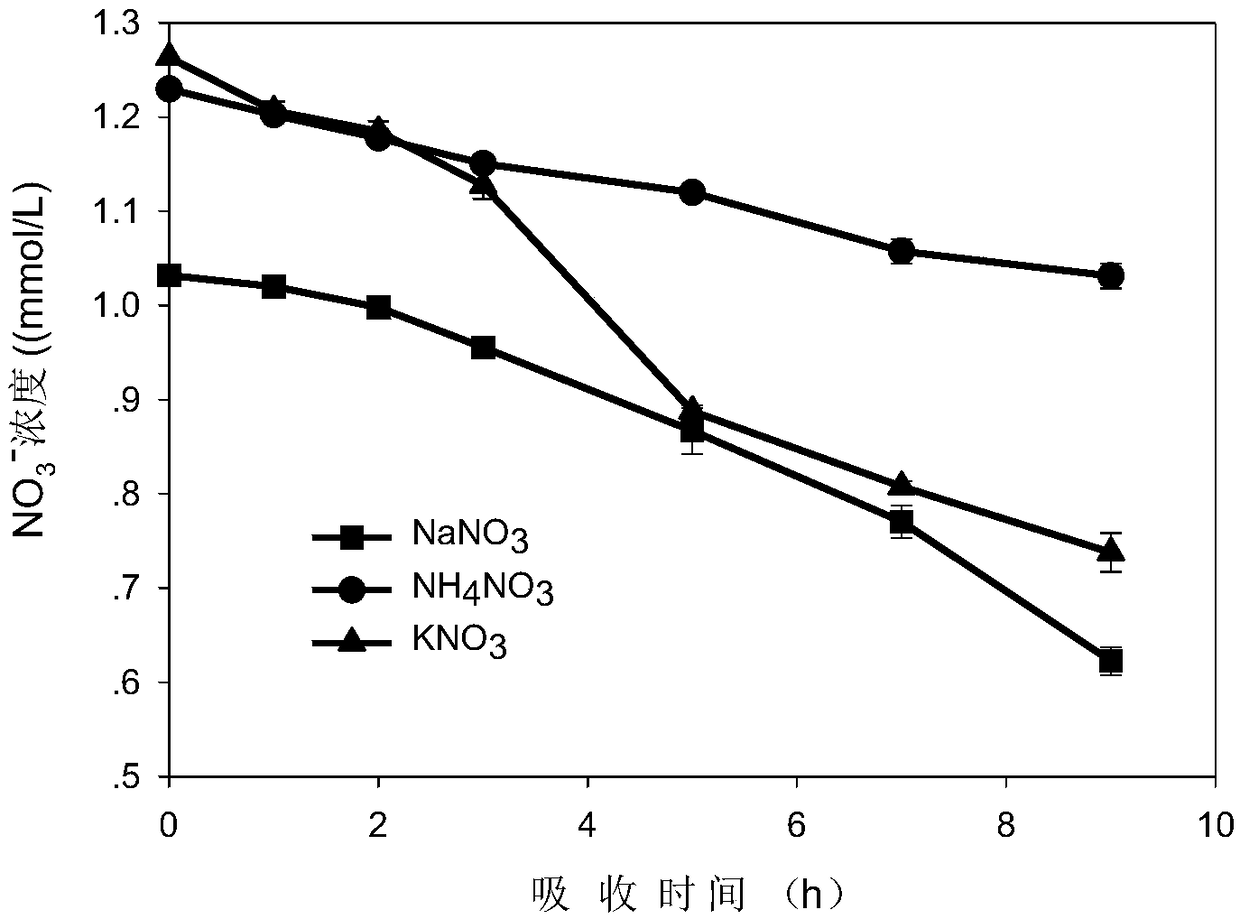Method for evaluating nitrate ion absorption kinetics of Acorus gramineus
A technology of nitrate ion and calamus, applied in the field of evaluating the kinetics of nitrate ion absorption by calamus, can solve the problems of one-sidedness and improper application, and achieve the effect of expanding the scope of application and changing the one-sided evaluation of kinetic characteristics
- Summary
- Abstract
- Description
- Claims
- Application Information
AI Technical Summary
Problems solved by technology
Method used
Image
Examples
Embodiment 1
[0040] 1) Select a number of calamus with the same plant height, good growth conditions, and no pests and diseases, and put them in 1 / 2 Hoagland nutrient solution (pH 5.8) for 1 month.
[0041] 2) Take out the calamus cultivated in step 1), and rinse the root with deionized water.
[0042] 3) the calamus calamus of step 2) is processed, changes into the CaSO of 0.2mmol / L 4solution, pre-incubated for 48h to achieve starvation.
[0043] 4) Transfer the starved calamus treated in step 3) into a black plastic bucket containing 1.5 L of absorption liquid. The composition of the absorption liquid is 1mmol / L NaNO 3 +0.2mmol / L CaSO 4 , and each absorption experiment was repeated 3 times.
[0044] 5) At 0, 1, 2, 3, 5, 7, and 9 hours, draw 10ml of absorption liquid from the plastic bucket, add 10ml of distilled water after sampling.
[0045] 6) Measure NO in the absorption liquid taken out in step 5) 3 - content.
[0046] 7) After the absorption experiment, the roots were cut of...
Embodiment 2
[0050] 1) Select Acorus calamus with consistent plant height, good growth conditions, and no pests and diseases, and put them in 1 / 2 Hoagland nutrient solution (pH5.8) for one month.
[0051] 2) Take out the calamus cultivated in step 1), and rinse the root with deionized water.
[0052] 3) the calamus calamus of step 2) is processed, changes into the CaSO of 0.2mmol / L 4 solution, pre-incubated for 48h to achieve starvation.
[0053] 4) Transfer the starved calamus treated in step 3) into a black plastic bucket containing 1.5 L of absorption liquid. The composition of the absorption liquid is 1mmol / L NH 4 NO 3 +0.2mmol / L CaSO 4 , and each absorption experiment was repeated 3 times.
[0054] 5) At 0, 1, 2, 3, 5, 7, and 9 hours, draw 10ml of absorption liquid from the plastic bucket, add 10ml of distilled water after sampling.
[0055] 6) Measure NO in the absorption liquid taken out in step 5) 3 - content.
[0056] 7) After the absorption experiment, the roots were cut...
Embodiment 3
[0060] 1) Select Acorus calamus with consistent plant height, good growth conditions, and no pests and diseases, and put them in 1 / 2 Hoagland nutrient solution (pH5.8) for one month.
[0061] 2) Take out the calamus cultivated in step 1), and rinse the root with deionized water.
[0062] 3) the calamus calamus of step 2) is processed, changes into the CaSO of 0.2mmol / L 4 solution, pre-incubated for 48h to achieve starvation.
[0063] 4) Transfer the starved calamus treated in step 3) into a black plastic bucket containing 1.5 L of absorption liquid. The composition of the absorption liquid is 1mmol / L KNO 3 +0.2mmol / L CaSO 4 , and each absorption experiment was repeated 3 times.
[0064] 5) At 0, 1, 2, 3, 5, 7, and 9 hours, draw 10ml of absorption liquid from the plastic bucket, add 10ml of distilled water after sampling.
[0065] 6) Measure NO in the absorption liquid taken out in step 5) 3 - content.
[0066] 7) After the absorption experiment, the roots were cut off,...
PUM
 Login to View More
Login to View More Abstract
Description
Claims
Application Information
 Login to View More
Login to View More - R&D
- Intellectual Property
- Life Sciences
- Materials
- Tech Scout
- Unparalleled Data Quality
- Higher Quality Content
- 60% Fewer Hallucinations
Browse by: Latest US Patents, China's latest patents, Technical Efficacy Thesaurus, Application Domain, Technology Topic, Popular Technical Reports.
© 2025 PatSnap. All rights reserved.Legal|Privacy policy|Modern Slavery Act Transparency Statement|Sitemap|About US| Contact US: help@patsnap.com


